PRINCETON, NJ -- The increased conservatism that Gallup first identified among Americans last June persisted throughout the year, so that the final year-end political ideology figures confirm Gallup's initial reporting: conservatives (40%) outnumbered both moderates (36%) and liberals (21%) across the nation in 2009.
More broadly, the percentage of Americans calling themselves either conservative or liberal has increased over the last decade, while the percentage of moderates has declined.
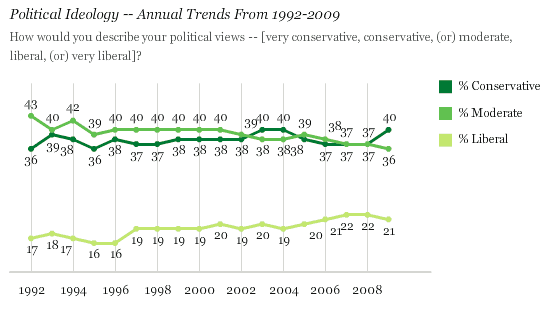
Since 1992, there have been only two other years -- 2003 and 2004 -- in which the average percentage of conservatives nationwide outnumbered moderates, and in both cases, it was by two percentage points (in contrast to the current four points).
"The proportion of independents calling themselves "moderate" held relatively steady in the mid-40s over the last decade, while the proportion of Republican and Democratic moderates dwindled."
The rather abrupt three-point increase between 2008 and 2009 in the percentage of Americans calling themselves conservative is largely owing to an increase -- from 30% to 35% -- in the percentage of political independents adopting the label. Over the same period, there was only a slight increase in professed conservatism among Republicans (from 70% to 71%) and no change among Democrats (at 21%).
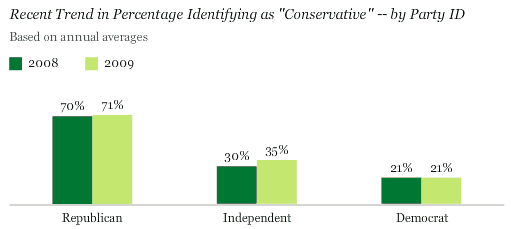
The 2009 findings come from an aggregate of 21 separate Gallup and USA Today/Gallup surveys, including nearly 22,000 interviews. The 1992 to 2008 trends also represent thousands of interviews compiled for each year. Thus, the margins of sampling error around the individual estimates are less than one percentage point.
Trends of the Past Decade
Just looking at the decade that ended in 2009, Gallup's annual political ideology trends document a slight dip in the percentage of Americans calling themselves moderate (from 40% in 2000 to 36% in 2009), while, at the same time, the ranks of both liberals and conservatives expanded slightly.
Gallup measures political ideology by asking Americans to indicate whether their political views are very conservative, conservative, moderate, liberal, or very liberal. The detailed responses show a slight increase between 2000 and 2009 in the percentage of Americans calling themselves "very conservative" (from 6% to 9%) and less change in the percentage calling themselves "very liberal" (from 4% to 5%). Most conservatives continue to call themselves "conservative" rather than "very conservative," and the same pattern is seen for liberals.
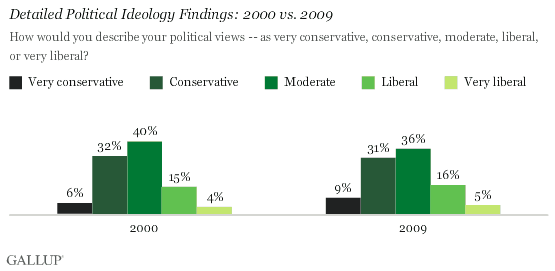
Republicans Become More Solidly "Conservative"
In addition to the very recent increase in conservatism among independents, a growing percentage of Republicans identified themselves as such starting in 2003. Across the same period, the percentage of Democrats calling themselves conservative dipped slightly, somewhat offsetting the increase among Republicans.
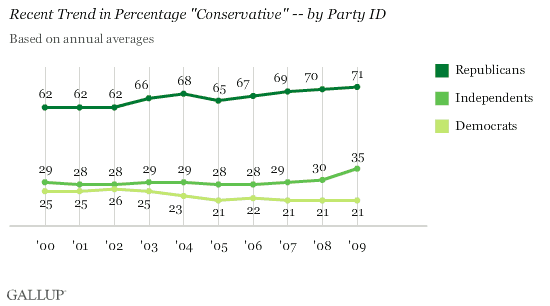
Partisans Shy Away From "Moderate" Label
The proportion of independents calling themselves "moderate" held relatively steady in the mid-40s over the last decade, while the proportion of Republican and Democratic moderates dwindled. Between 2000 and 2009, the percentage of moderates fell five percentage points among Democrats (from 44% to 39%) and seven points among Republicans (from 31% to 24%).
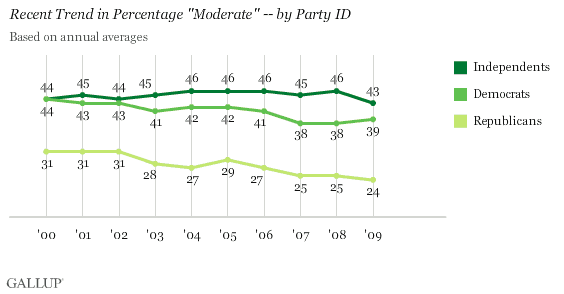
Democrats Grow Increasingly "Liberal"
Similar to the increased conservatism among Republicans, there was a gradual increase in the last decade in "liberal" identification among Democrats, from 29% in 2002 to 38% in 2007, and it has since remained at about that level.
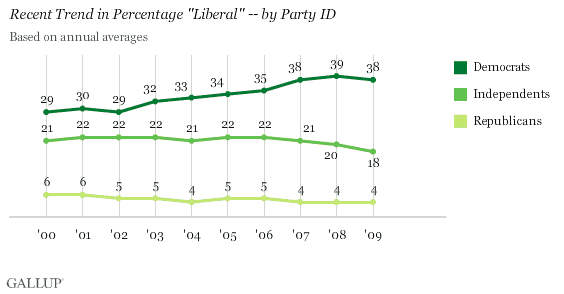
The effect of this shift among Democrats is most apparent when one reviews the trend in their ideological profile over the past decade. Whereas moderates constituted the largest bloc of Democrats in 2000, today they are about tied with liberals as twin leaders, and the proportion of conservatives has declined.
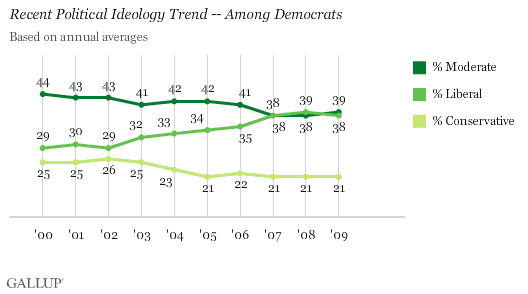
By contrast, the expanded number of conservatives making up the Republican Party has merely strengthened the conservatives' already strong hold on that party.
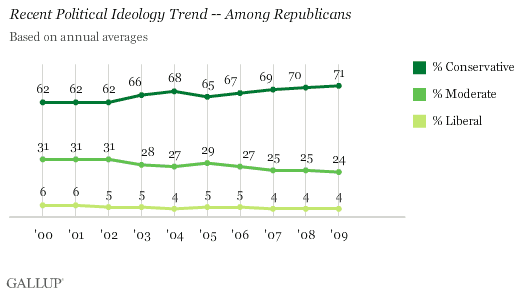
And despite the recent uptick in conservatism among independents, the largest segment continues to be moderate (although by a smaller margin than previously).
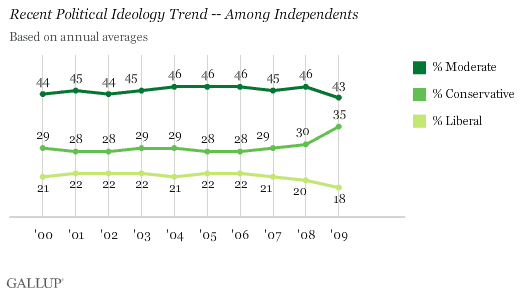
Bottom Line
Political independents showed increased attachment to the "conservative" label in 2009, boosting the overall ranks of that group so that it now clearly outnumbers moderates in Gallup's annual averages for the first time since 2004. Longer term, the proportions of Americans calling themselves conservative as well as liberal expanded slightly this past decade, largely because of increased partisan attachment to each label. At the same time, the percentage of "moderates" has dwindled, underscoring the heightened polarization of American politics as the nation heads into a new decade.
Survey Methods
Results are based on aggregated data from Gallup polls conducted in 2009, each based on telephone interviews with 1,000 or more national adults, aged 18 and older. For results based on the total sample of 21,905 national adults, one can say with 95% confidence that the maximum margin of sampling error is ±1 percentage point.
Other results are based on aggregated Gallup surveys of approximately 1,000 national adults 18 and older each. Sample sizes for the annual compilations range from approximately 10,000 to approximately 40,000. For these results, one can say with 95% confidence that the maximum margin of sampling error is ±1 percentage point.
In addition to sampling error, question wording and practical difficulties in conducting surveys can introduce error or bias into the findings of public opinion polls.
